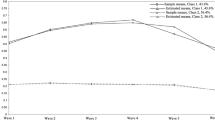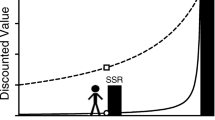Abstract
Recent findings from developmental neuroscience suggest that the adolescent brain is too immature to exert control over impulsive drives, such as sensation seeking, that increase during adolescence. Using a discounting of delayed reward paradigm, this research examines the ability to delay gratification as a potential source of control over risk-taking tendencies that increase during adolescence. In addition, it explores the role of experience resulting from risk taking as well as future time perspective as contributors to the development of this ability. In a nationally representative sample (n = 900) of young people aged 14–22, a structural equation analysis shows that risk taking as assessed by use of three popular drugs (tobacco, marijuana, and alcohol) is inversely related to the ability to delay gratification. The relation is robust across gender, age, and different levels of sensation seeking. In addition, high sensation seekers exhibit dramatic age-related increase in delay of gratification, lending support to the hypothesis that engaging in risky behavior provides experience that leads to greater patience for long-term rewards. The findings support the conclusion that a complete understanding of the development of self-control must consider individual differences not easily explained by universal trends in brain maturation.



Similar content being viewed by others
References
Ainslie, G. (1975). Specious reward: A behavioral theory of impulsiveness and impulse control. Psychological Bulletin, 82, 463–496.
Allison, P. D. (2001). Missing data. Thousand Oaks, CA: Sage.
Bembenutty, H. F., & Karabenick, S. A. (2004). Inherent association between academic delay of gratification, future time perspective, and self-regulated learning. Educational Psychology Review, 16, 35–57.
Bentler, P. M. (2004). EQS 6 structural equation manual. Encino, CA: Multivariate Software, Inc.
Botvin, G. J., Griffin, K. W., & Nichols, T. D. (2006). Preventing youth violence and delinquency through a universal school-based prevention approach. Prevention Science, 7, 403–408.
Boyd, J. N., Keough, K. A., & Zimbardo, P. G. (1999). Who’s smoking, drinking, and using drugs? Time perspective as a predictor of substance use. Basic and Applied Social Psychology, 21, 149–164.
Casey, B. J., Getz, S., & Galvan, A. (2008). The adolescent brain. Developmental Review, 28, 62–77.
Chambers, R. A., Potenza, M. N., & Taylor, J. R. (2003). Developmental neurocircuitry of motivation in adolescence: A critical period of addiction vulnerability. American Journal of Psychiatry, 160, 1041–1052.
Donohew, L., Hoyle, R. H., Lorch, E. P., Palmgreen, P., & Stephenson, M. T. (2002). Reliability and validity of a brief measure of sensation seeking. Personality and Individual Differences, 32, 401–414.
Duckworth, A. L., & Seligman, M. E. P. (2005). Self-discipline outdoes IQ in predicting academic performance of adolescents. Psychological Science, 16, 939–944.
Evans, G. W., & Rosenbaum, J. (2008). Self-regulation and the income-achievement gap. Early Childhood Research Quarterly, 23, 504–514.
Fong, G. T., & Hall, P. A. (2003). Time perspective: A potentially important construct for decreasing health risk behaviors among adolescents. In D. Romer (Ed.), Reducing adolescent risk: Toward an integrated approach (pp. 106–112). Thousand Oaks, CA: Sage.
Green, L., & Myerson, J. (2004). A discounting framework for choice with delayed and probabilistic rewards. Psychological Bulletin, 130, 769–792.
Green, L., Fry, A. F., & Myerson, J. (1994). Discounting of delayed rewards: A life-span comparison. Psychological Science, 5, 33–36.
Green, L., Myerson, J., Lichtman, D., Rosen, S., & Fry, A. (2008). Temporal discounting in choice between delayed rewards: The role of age and income. Psychology and Aging, 11, 79–84.
Hinton, J. M., Jameson, T. L., & Whitney, P. (2003). Impulsive decision-making and working memory. Journal of Experimental Psychology: Learning, Memory, and Cognition, 29, 298–306.
Hu, L., & Bentler, P. M. (1995). Evaluating model fit. In R. H. Hoyle (Ed.), Structural equation modeling: Concepts, issues, and applications (pp. 76–99). Newbury Park, CA: Sage.
Jentsch, D., & Taylor, J. R. (1999). Impulsivity resulting from frontostriatal dysfunction in drug abuse: Implications for the control of behavior by rewardrelated stimuli. Psychopharmacology, 146, 373–390.
Johnson, M. W., & Bickel, W. (2002). Within-subject comparison of real and hypothetical money rewards in delay discounting. Journal of the Experimental Analysis of Behavior, 77, 129–146.
Johnston, L. D., O’Malley, P. M., Bachman, J. G., & Schulenberg, J. E. (2008). Monitoring the future national survey results on drug use, 1975–2007: Vol. 1. Secondary school students (NIH Publication N. 08-64-18A). Bethesda, MD: National Institute on Drug Abuse.
Joireman, J., Sprott, D. E., & Spangenberg, E. R. (2005). Fiscal responsibility and the consideration of future consequences. Personality and Individual Differences, 39, 1159–1168.
Kaplan, D. (2000). Structural equation modeling. Thousand Oaks, CA: Sage.
Klingberg, T., Fernell, E., Olesen, P., Johnson, M., Gustafsson, P., Dahlstrom, K., et al. (2005). Computerized training of working memory in children with ADHD—A randomized controlled trial. Journal of the American Academy of Child and Adolescent Psychiatry, 44, 177–186.
Lewin, K. (1939). Field theory and experiment in social psychology: Concepts and methods. American Journal of Sociology, 44, 868–896.
McCartt, A. T., Shabanova, V. I., & Leaf, W. A. (2003). Driving experience, crashes and traffic citations of teenage beginning drivers. Accident Analysis and Prevention, 35, 311–320.
Mischel, W., Peake, P. K., & Shoda, Y. (1988). The nature of adolescent competencies predicted by preschool delay of gratification. Journal of Personality and Social Psychology, 54, 687–696.
Mischel, W., Shoda, Y., & Rodriguez, M. L. (1989). Delay of gratification in children. Science, 244, 933–938.
Moffitt, T. E. (1993). Adolescence-limited and life-course-persistent antisocial behavior: A developmental taxonomy. Psychological Review, 100, 674–701.
Morrissey, M. A., Grabowski, D. C., Dee, T. S., & Campbell, C. (2006). The strength of graduated drivers license programs and fatalities among teens and passengers. Accident Analysis and Prevention, 38, 135–141.
Nelson, C. A., Bloom, F. E., Cameron, J. L., Amaral, D., Dahl, R. E., & Pine, D. (2002). An integrative, multidisciplinary approach to the study of brain-behavior relations in the context of typical and atypical development. Development and Psychopathology, 14, 499–520.
Nurmi, J. (1991). How do adolescents see the future? A review of the development of future orientation and planning. Developmental Review, 11, 1–59.
Panksepp, J. (1998). Affective neuroscience: The foundations of human and animal emotions. New York: Oxford University Press.
Pattij, T., & Vanderschuren, L. J. M. J. (2008). The neuropharmacology of impulsive behavior. Trends in Pharmacological Sciences, 29, 192–199.
Rachlin, H. (2000). The science of self-control. Cambridge, MA: Harvard University Press.
Raine, A., Reynolds, C., Venables, P. H., & Mednick, S. A. (2002). Stimulation seeking and intelligence: A prospective longitudinal study. Journal of Personality and Social Psychology, 82, 663–674.
Raykov, T. (1997). Estimation of composite reliability for congeneric measures. Applied Psychological Measurement, 21, 173–184.
Reynolds, B. (2004). Do high rates of cigarette consumption increase delay discounting? A cross-sectional comparison of adolescent smokers and young-adult smokers and nonsmokers. Behavioural Processes, 67, 545–549.
Reynolds, B. (2006). A review of delay-discounting research with humans: Relations to drug use and gambling. Behavioural Pharmacology, 17, 651–667.
Reynolds, B., & Schiffbauer, R. (2005). Delay of gratification and delay discounting: A unifying feedback model of delay-related impulsive behavior. Psychological Record, 55, 439–460.
Reynolds, B., Penfold, R. B., & Patak, M. (2008). Dimensions of impulsive behavior in adolescents: Laboratory behavioral assessments. Experimental and Clinical Psychopharmacology, 16, 124–131.
Riggs, N. R., Greenberg, M. T., Kusche, C. A., & Pentz, M. A. (2006). The meditational role of neurogcognition in the behavioral outcomes of a social-emotional prevention program in elementary school students: Effects of the PATHS curriculum. Prevention Science, 7, 91–102.
Roberti, J. W. (2004). A review of behavioral and biological correlates of sensation seeking. Journal of Research in Personality, 38, 256–279.
Romer, D., & Hennessy, M. (2007). A biosocial-affect model of adolescent sensation seeking: The role of affect evaluation and peer-group influence in adolescent drug use. Prevention Science, 8, 89–101.
Rueda, M. R., Rothbart, M. K., McCandliss, B. D., Saccamanno, L., & Posner, M. I. (2005). Training, maturation, and genetic influences on the development of executive attention. Proceedings of the National Academy of Sciences, 102, 14931–14936.
Satorra, A., & Bentler, P. M. (1994). Corrections to test statistics and standard errors in covariance structure analysis. In A. von Eye, & C. C. Clogg (Eds.), Latent variables analysis: Applications for developmental research (pp. 399–419). Thousand Oaks, CA: Sage.
Schultz, W. (2002). Getting formal with dopamine and reward. Neuron, 36, 241–263.
Shamosh, N. A., DeYoung, C. G., Green, A. E., Reis, D. L., Johnson, M. R., Conway, A. R. A., et al. (2008). Individual differences in delay discounting: Relation to intelligence, working memory, and anterior prefrontal cortex. Psychological Science, 19, 904–911.
Shedler, J., & Block, J. (1990). Adolescent drug use and psychological health: A longitudinal inquiry. American Psychologist, 45, 612–630.
Smith, G. T., Fischer, S., Cyders, M. A., Annus, A. M., Spillane, N. S., & McCarthy, D. M. (2007). On the validity and utility of discriminating among impulsivity-like traits. Assessment, 14, 155–170.
Spanagel, R., & Weiss, F. (1999). The dopamine hypothesis of reward: Past and current status. Trends in Neuroscience, 22, 521–527.
Spear, L. P. (2000). Neurobehavioral changes in adolescence. Current Directions in Psychological Science, 9, 111–114.
Spear, L. P. (2007). The developing brain and adolescent-typical behavior patterns: An evolutionary approach. In D. Romer & E. Walker (Eds.), Adolescent psychopathology and the developing brain: Integrating brain and prevention science (pp. 9–30). New York: Oxford University Press.
Steinberg, L. (2008). A social neuroscience perspective on adolescent risk taking. Developmental Review, 28, 78–106.
Steinberg, L., Graham, S., O’Brien, L., Woolard, J., Cauffman, E., & Banich, M. (2009). Age differences in future orientation and delay discounting. Child Development, 80, 28–44.
Substance Abuse and Mental Health Services Administration, Office of Applied Studies (2008). Results from the 2007 National Survey on Drug Use and Health: National Findings (NSDUH Series H-34, DHHS Publication No. SMA 08-4343). Rockville, MD.
Turner, M. G., & Piquero, A. R. (2002). The stability of self-control. Journal of Criminal Justice, 30, 457–471.
U.S. Bureau of the Census. (2001). Estimates of the population of the United States, by age, sex, and race: 1990 to 1999. Washington, DC: U.S. Bureau of the Census.
Verdejo-Garcia, A., Lawrence, A. J., & Clark, L. (2008). Impulsivity as a vulnerability marker for substance-use disorders: Review of findings from high-risk research, problem gamblers, and genetic association studies. Neuroscience and Biobehavioral Reviews, 32, 777–810.
Wallace, J. M., Bachman, J. G., O’Malley, P. M., Schulenberg, J. E., Cooper, S. M., & Johnston, L. D. (2003). Gender and ethnic differences in smoking, drinking, and illicit drug use among American 8th, 10th and 12th grand students, 1976–2000. Addiction, 98, 225–234.
Whiteside, S. P., & Lynam, D. R. (2001). The five factor model and impulsivity: Using a structural model of personality to understand impulsivity. Personality and Individual Differences, 30, 669–689.
Wilson, M., & Daly, M. (2006). Are juvenile offenders extreme future discounters? Psychological Science, 17(11), 989–994.
Winfree, L. T., Taylor, T. J., He, N., & Esbensen, F.-A. (2006). Self-control and variability over time: Multivariate results using a 5-year multisite panel of youths. Crime & Delinquency, 52, 253–286.
Zald, D. H., Cowan, R. L., Riccardi, P., Baldwin, R. M., Ansari, M. S., Li, R., et al. (2008). Midbrain dopamine receptor availability is inversely associated with novelty-seeking traits in humans. The Journal of Neuroscience, 28, 14372–14378.
Zimbardo, P. G., & Boyd, J. N. (1999). Putting time in perspective: A valid, reliable individual-differences metric. Journal of Personality and Social Psychology, 77, 1271–1288.
Zuckerman, M. (1994). Biobehavioral expressions and biosocial bases of sensation seeking. New York: Cambridge University Press.
Author information
Authors and Affiliations
Corresponding author
Rights and permissions
About this article
Cite this article
Romer, D., Duckworth, A.L., Sznitman, S. et al. Can Adolescents Learn Self-control? Delay of Gratification in the Development of Control over Risk Taking. Prev Sci 11, 319–330 (2010). https://doi.org/10.1007/s11121-010-0171-8
Published:
Issue Date:
DOI: https://doi.org/10.1007/s11121-010-0171-8




